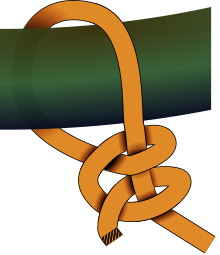Round trip with two half beats
| Round trip with two half beats | |
|---|---|

|
|
| Type | Mooring lines |
| application | Attachment to an object |
| Ashley No. | 1720 , 1835 |
| English | Round turn and two half hitches, Anchor Bend |
| List of nodes | |
The round trip with two half twists is a knot for securely attaching a line to an object.
application
This knot can also be tied and untied under tension. It is suitable for tying to poles, rings, bollards or other objects and is very reliable. A ship can be checked while mooring on the very first voyage at the bollard. The knot can also be used in the middle of the rope.
Knot
First a round turn is placed around a bar or a ring, then two half beats are placed around the standing part . It should be noted that the two half strokes have the same direction of rotation around the standing part and thus form a loom line and not an anchor stitch .
If the remaining rope is long, a long bay is placed in this and the final loom is tied with this bay. The rope is looped around the bollard twice and the two half-turns are then tied with a bay (the first half-turn is then on slip ).
Alternatives
- Climbers use the figure-of-eight knot or double bulin for roping up .
- The bowline is used for a variety of purposes in seafaring .
- To a pole to use the seafaring clove hitch .
- The carpenter's strike is used in the building trade .
- Riders tie horses with the horse tying knot .
Modifications
- If the object is only wrapped around with a single trip and fastened around its own standing part, one speaks of only two half strokes (ABoK # 1710). The difference to the weaving line is that the weaving line is tied around the object.
- If a half-mast cast is made instead of the round trip , a backhanded hitch occurs . With it, the load can be better controlled. If the bollard is very wide, so that it would be too much effort to run the rope around twice, you can lead around a bay once and put the loose part through the bay. This also results in a half-mast cast that can capsize into its first shape under load.
- If the first half beat is passed through the two round turns and the second half beat is left out, the Roringstek is created .
Individual evidence
- ↑ Clifford W. Ashley: The Ashley Book of Knots . Translated by Gerhard Meyer-Uhl. Edition Maritim, Hamburg 1999, ISBN 3-922117-37-6 , pp. 305 (# 1710) .
- ↑ Clifford Ashley: Ashley Book of Knots . Number 1797 (German translation: "opposite blow").
- ↑ Clifford Ashley: Ashley Book of Knots . Number 1725 (German translation: "Kontrastek").




